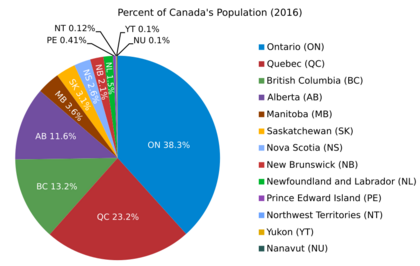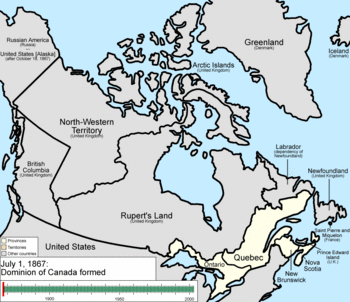Provinces and territories of Canada facts for kids
Quick facts for kids
|
|
|---|---|
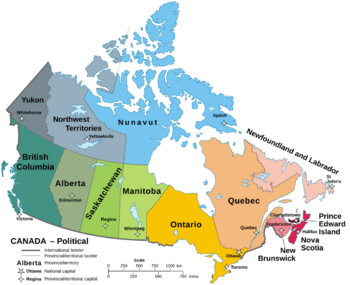 |
|
| Category | Federated state |
| Number |
|
| Government | Constitutional monarchy |
Canada is a very large country with ten provinces and three territories. These are like big regions or states that help manage the country. They are all part of Canada under the rules of the Canadian Constitution.
In 1867, three areas of British North America—New Brunswick, Nova Scotia, and the Province of Canada (which became Ontario and Quebec)—joined together. This event, called the Canadian Confederation, created Canada as a new country. Over time, Canada grew and added more provinces and territories. Today, Canada is the second-largest country in the world by land area.
The main difference between a Canadian province and a territory is where they get their power. Provinces get their power directly from the Constitution Act, 1867. This means they have a lot of control over their own affairs. Territories, on the other hand, get their powers from the Parliament of Canada. The federal government gives them their authority.
The Constitution Act explains how power is shared between the federal government (for all of Canada) and the provincial governments. If you want to change how powers are divided for provinces, you need to change the Constitution. But for territories, the federal government can make changes more easily.
Provinces are seen as having their own special authority, almost like mini-countries within Canada. Each province has a lieutenant governor who represents the Canadian Crown (the King or Queen). Territories are not as independent; they have a commissioner who represents the federal government.
Contents
Canada's Provinces: A Closer Look
Canada has ten provinces, each with its own capital city and unique features. These provinces are home to most of Canada's population. They manage many important services for their residents.
| Name and postal abbr. | Cities | Entered Confederation | Official language(s) |
Population | Area (km2) | Seats | ||||||
|---|---|---|---|---|---|---|---|---|---|---|---|---|
| Capital | Largest | 2021 census | Q1 2025 estimates |
Land | Water | Total | Commons | Senate | ||||
| Ontario | ON | Toronto | July 1, 1867 | English |
14,223,942
|
16,182,641
|
917,741
|
158,654
|
1,076,395
|
122 | 24 | |
| Quebec | QC | Quebec City | Montreal | French |
8,501,833
|
9,111,629
|
1,356,128
|
185,928
|
1,542,056
|
78 | 24 | |
| Nova Scotia | NS | Halifax | English |
969,383
|
1,079,627
|
53,338
|
1,946
|
55,284
|
11 | 10 | ||
| New Brunswick | NB | Fredericton | Moncton | English, French |
775,610
|
858,963
|
71,450
|
1,458
|
72,908
|
10 | 10 | |
| Manitoba | MB | Winnipeg | July 15, 1870 | English |
1,342,153
|
1,504,023
|
553,556
|
94,241
|
647,797
|
14 | 6 | |
| British Columbia | BC | Victoria | Vancouver | July 20, 1871 | English |
5,000,879
|
5,722,318
|
925,186
|
19,549
|
944,735
|
43 | 6 |
| Prince Edward Island | PE | Charlottetown | July 1, 1873 | English |
154,331
|
179,280
|
5,660
|
0
|
5,660
|
4 | 4 | |
| Saskatchewan | SK | Regina | Saskatoon | September 1, 1905 | English |
1,132,505
|
1,250,909
|
591,670
|
59,366
|
651,036
|
14 | 6 |
| Alberta | AB | Edmonton | Calgary | English |
4,262,635
|
4,960,097
|
642,317
|
19,531
|
661,848
|
37 | 6 | |
| Newfoundland and Labrador | NL | St. John's | March 31, 1949 | English |
510,550
|
545,579
|
373,872
|
31,340
|
405,212
|
7 | 6 | |
| Total provinces |
36,873,821
|
41,395,066
|
5,490,918
|
572,013
|
6,062,931
|
343 | 102 | |||||
Canada's Territories: The North
Canada has three territories. They are different from provinces because their governments get their powers from the federal government, not directly from the Constitution. These territories cover a huge part of northern Canada. They include all the land north of latitude 60° north and many islands.
Even though territories cover 40% of Canada's land, only a small part of the population (about 0.3%) lives there. This makes them very sparsely populated.
| Name and postal abbr. | Cities | Entered Confederation | Official languages | Population | Area (km2) | Seats | ||||||
|---|---|---|---|---|---|---|---|---|---|---|---|---|
| Capital | Largest | 2021 census | Q1 2025 estimates |
Land | Water | Total | Commons | Senate | ||||
| Northwest Territories | NT | Yellowknife | July 15, 1870 | Chipewyan, Cree, English, French, Gwichʼin, Inuinnaqtun, Inuktitut, Inuvialuktun, North Slavey, South Slavey, Tłįchǫ |
41,070
|
45,074
|
1,183,085
|
163,021
|
1,346,106
|
1 | 1 | |
| Yukon | YT | Whitehorse | June 13, 1898 | English, French |
40,232
|
47,126
|
474,391
|
8,052
|
482,443
|
1 | 1 | |
| Nunavut | NU | Iqaluit | April 1, 1999 | Inuinnaqtun, Inuktitut, English, French |
36,858
|
41,414
|
1,936,113
|
157,077
|
2,093,190
|
1 | 1 | |
| Total territories |
118,160
|
133,614
|
3,593,589
|
328,150
|
3,921,739
|
3 | 3 | |||||
Population Distribution Across Canada
Most of Canada's population lives close to the border with the United States. The four largest provinces by land area—Quebec, Ontario, British Columbia, and Alberta—are also the most populated. Together, they are home to about 86% of all Canadians.
The three territories (Northwest Territories, Nunavut, and Yukon) cover more than a third of Canada's land. However, only a tiny fraction (0.3%) of Canada's population lives there. This means these northern regions are very vast and empty.
Canada's population has generally grown over time. Between 2011 and 2016, the population grew by 5.0%. Almost all provinces and territories saw an increase in people during this period. Nunavut had the fastest growth, increasing by 12.7%.
Historically, Ontario and Quebec have always been the two biggest provinces by population. They have consistently held over 60% of Canada's total population. The population in the West has grown steadily, while the population in Atlantic Canada has seen some declines.
How Canada's Map Changed Over Time
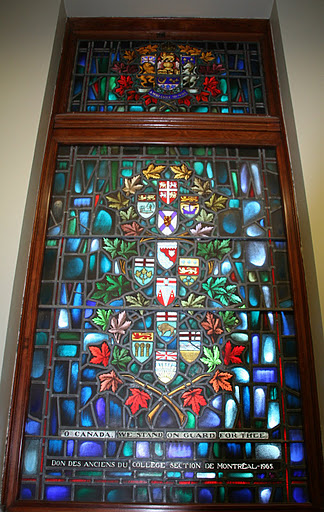
Canada began with four original provinces on July 1, 1867: Ontario, Quebec, New Brunswick, and Nova Scotia. These were once British colonies that joined together. Over the next few years, more areas joined: Manitoba in 1870, British Columbia in 1871, and Prince Edward Island in 1873.
In 1870, a huge area called Rupert's Land and the North-Western Territory was bought by the Canadian government from the Hudson's Bay Company. This vast land became the Province of Manitoba and the North-West Territories.
The North-West Territories was enormous, covering much of what is now northern and western Canada. In 1880, Britain gave its claims to the Arctic islands to Canada, making the North-West Territories even bigger. In 1898, the Yukon Territory was created from part of this area.
In September 1905, two new provinces were formed from the North-West Territories: Alberta and Saskatchewan. In 1912, the borders of Quebec, Ontario, and Manitoba were expanded northward.
Newfoundland and Labrador was the last province to join Canada. In 1869, the people of Newfoundland decided to remain a British colony. However, after a difficult economic period and World War II, they voted to join Canada. On March 31, 1949, Newfoundland became Canada's tenth province. The province was later renamed Newfoundland and Labrador in 2001.
In 1999, a new territory called Nunavut was created from the eastern and northern parts of the Northwest Territories. This was an important step for the Inuit people who live there.
How Provincial and Territorial Governments Work
Provinces have a lot of power over important services like healthcare, education, and transportation within their borders. They collect their own taxes and also receive money, called "transfer payments," from the federal government to help pay for these services. The federal government can sometimes set rules for how this money is used, for example, to ensure everyone has access to medical care.
Each province and territory has its own law-making body, similar to a mini-parliament. Most provinces call theirs the Legislative Assembly. Nova Scotia and Newfoundland and Labrador call theirs the House of Assembly, and Quebec calls its the National Assembly. Ontario's members are called Members of the Provincial Parliament (MPPs).
The leader of the government in each province is called the Premier. The Premier is usually the head of the political party that wins the most seats in an election. In the territories of Yukon, Northwest Territories, and Nunavut, the leader is also called the Premier, but their governments often work without political parties.
The King's representative in each province is the lieutenant governor. In the territories, there is a commissioner who represents the federal government.
| Jurisdiction | Legislature | Lower house | Members of lower house | Superior court | Head of government | Viceroy |
|---|---|---|---|---|---|---|
| Canada | Parliament | House of Commons | Member of Parliament (MP) | Federal Court | Prime minister | Governor general |
| Ontario | Parliament | Legislative Assembly | Member of the Provincial Parliament (MPP) | Superior Court of Justice | Premier | Lieutenant governor |
| Quebec | Legislature | National Assembly | Member of the National Assembly (MNA) | Superior Court | ||
| Nova Scotia | General Assembly | House of Assembly | Member of the Legislative Assembly (MLA) | Supreme Court | ||
| New Brunswick | Legislature | Legislative Assembly | Court of King's Bench | |||
| Manitoba | ||||||
| British Columbia | Parliament | Supreme Court | ||||
| Prince Edward Island | General Assembly | |||||
| Saskatchewan | Legislature | Court of King's Bench | ||||
| Alberta | ||||||
| Newfoundland and Labrador | General Assembly | House of Assembly | Member of the House of Assembly (MHA) | Supreme Court | ||
| Northwest Territories | Assembly | Legislative Assembly | Member of the Legislative Assembly | Supreme Court | Premier | Commissioner |
| Yukon | Legislature | |||||
| Nunavut | Assembly | Court of Justice | ||||
Provincial Legislature Buildings
Territorial Legislature Buildings
Map of Canada's Divisions
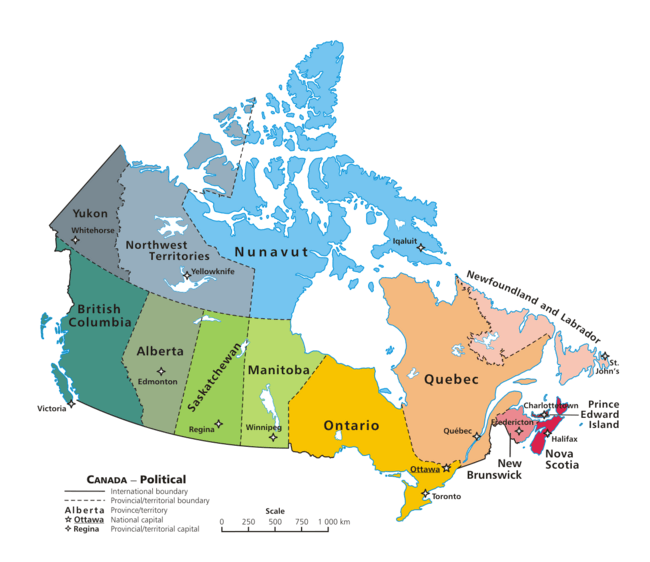
Provincial Political Parties and Governments
Each province has its own political parties. These parties often have similar names to the national (federal) parties, but they usually work independently. For example, provincial Conservative parties are not officially linked to the federal Conservative Party of Canada.
However, some parties are more connected. Provincial New Democratic Parties are fully part of the federal New Democratic Party. This means they share members and work closely together. The Liberal Party of Canada also has strong links with its provincial counterparts in Atlantic Canada.
Some provinces have unique parties that don't have a clear federal equivalent, like the Alberta Party and Saskatchewan Party. In Quebec, the political scene is different, with parties focused on whether Quebec should remain part of Canada or become an independent country.
Currently, most provincial governments are led by a single party with a majority of seats. However, Yukon has a minority government, meaning the leading party needs support from another party to pass laws.
| Province/territory | Premier | Party in government | Main focus | Political leaning | Majority/ |
Party in Opposition | Lieutenant governor / commissioner | Last election | Next election | |
|---|---|---|---|---|---|---|---|---|---|---|
| Alberta | Danielle Smith | United Conservative | Focus on lower taxes and individual freedom | Centre-right to right-wing | Majority | New Democratic | Salma Lakhani | 2023 | 2027 | |
| British Columbia | David Eby | New Democratic | Focus on social programs and equality | Centre-left | Majority | Conservative | Wendy Lisogar-Cocchia | 2024 | 2028 | |
| Manitoba | Wab Kinew | New Democratic | Focus on social programs and equality | Centre-left | Majority | Progressive Conservative | Anita Neville | 2023 | 2027 | |
| New Brunswick | Susan Holt | Liberal | Focus on individual rights and freedoms | Centre to centre-left | Majority | Progressive Conservative | Louise Imbeault | 2024 | 2028 | |
| Newfoundland and Labrador | John Hogan | Liberal | Focus on individual rights and freedoms | Centre | Majority | Progressive Conservative | Joan Marie Aylward | 2021 | 2025 | |
| Nova Scotia | Tim Houston | Progressive Conservative | Focus on traditional values and balanced budgets | Centre-right | Majority | New Democratic | Mike Savage | 2024 | 2029 | |
| Ontario | Doug Ford | Progressive Conservative | Focus on lower taxes and economic growth | Centre to centre-right | Majority | New Democratic | Edith Dumont | 2025 | 2029 | |
| Prince Edward Island | Rob Lantz | Progressive Conservative | Focus on balanced budgets and community | Centre to centre-right | Majority | Liberal | Wassim Salamoun | 2023 | 2027 | |
| Quebec | François Legault | Coalition Avenir Québec | Focus on Quebec's interests and economy | Centre-right | Majority | Liberal | Manon Jeannotte | 2022 | 2026 | |
| Saskatchewan | Scott Moe | Saskatchewan Party | Focus on economic growth and rural areas | Centre-right to right-wing | Majority | New Democratic | Bernadette McIntyre | 2024 | 2028 | |
| Northwest Territories | R.J. Simpson | Nonpartisan consensus government | N/A | Gerald Kisoun | 2023 | 2027 | ||||
| Nunavut | P.J. Akeeagok | Nonpartisan consensus government | N/A | Eva Aariak | 2021 | 2025 | ||||
| Yukon | Mike Pemberton | Liberal | Focus on individual rights and freedoms | Centre | Minority | Yukon Party | Adeline Webber | 2021 | 2025 | |
See also
 In Spanish: Organización territorial de Canadá para niños
In Spanish: Organización territorial de Canadá para niños


